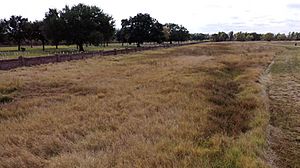Freedmen's Cemetery facts for kids

Freedmen's Cemetery in 2019
|
|
| Details | |
|---|---|
| Established | 1867 |
| Location |
Chalmette, Louisiana, formerly considered New Orleans, Louisiana
|
| Country | United States |
| No. of graves | ~4,000 |
The Freedmen's Cemetery was a special burial ground in St. Bernard Parish, Louisiana. It was a place where formerly enslaved people, both adults and children, were buried after the American Civil War ended.
This cemetery was started in 1867. It was about four acres big and was created by the U.S. Bureau of Refugees, Freedmen, and Abandoned Lands. This group is also known as the Freedmen's Bureau. The cemetery was right next to Monument Cemetery, which is now called the Chalmette National Cemetery. The U.S. government had started burying Union soldiers there in 1864.
The Freedmen's Cemetery was used until 1876. Today, it is seen as one of the Historic Cemeteries of New Orleans. There is a special historical marker near the entrance of Chalmette National Cemetery to remember it.
Contents
History of the Freedmen's Cemetery
What was the Freedmen's Bureau?
The Freedmen's Bureau was a government group created on March 3, 1865. It was part of the United States Department of War. Its main job was to help people who had been enslaved become free citizens. This included helping with housing, education, and medical care.
The bureau faced many challenges, like not having enough money. They also had to deal with the difficult politics of the time after the Civil War.
How the Cemetery Started
The Chalmette National Cemetery was created about a year before the Freedmen's Cemetery. It was a place to bury Union soldiers and sailors who died in Louisiana. This land was first used as a camp for freed slaves. It later became a burial ground for former slaves and sick people.
Over time, more civilians were buried there than soldiers. So, in 1867, the government got four acres of land next to the national cemetery. They moved about two to four thousand civilian bodies from Chalmette to this new spot. This new area became the Freedmen's Cemetery.
Life of the Cemetery
Most new burials at Freedmen's Cemetery came from Freedmen's Hospitals in Louisiana. About 716 people were buried there between 1867 and 1869. At first, the cemetery was well cared for. Graves had wooden markers, and records were kept. These records listed names and causes of death.
Today, these original records are kept by the U.S. National Archives. You can also find digital copies on family history websites.
The Cemetery's End
Over time, the Freedmen's Hospitals closed down. By 1872, the entire Freedmen's Bureau agency stopped working. In 1873, a government memo said that the Freedmen's Cemetery was no longer being used.
The U.S. government decided not to own or care for the land anymore. In 1874, they built a brick wall to separate the two cemeteries. Ownership of the Freedmen's Cemetery land was given back to the City of New Orleans. The city then sold the land in 1875 to Louisiana's Agricultural & Mechanical College.
The college tried to get the national cemetery to take over the land. They saw that some U.S. Colored Troops might be buried there. But the federal government did not take action.
The Cemetery Today
Today, the cemetery is part of the Chalmette Battlefield. This area is now part of the Jean Lafitte National Historical Park and Preserve. Scientists have used special radar to study the ground. However, the results were not clear. The river levee was once very low, so the area often flooded. This added more dirt on top of the original soil.
People Buried at Freedmen's Cemetery
Many people were buried at the Freedmen's Cemetery. This included over eighty men, women, and children. They had died at the Freedmen's Bureau Hospital in New Orleans between May and July 1867. Their names, dates of death, and burial spots were all written down in records. These records are at the National Archives.
People died from many different illnesses. Some common causes of death included:
- Age-related weakness
- Swelling (anasarca, dropsy, edema)
- Brain problems (apoplexy, brain inflammation, epilepsy, paralysis)
- Infections (cholera, dysentery, gangrene, smallpox, tetanus)
- Lung problems (lung inflammation, phthisis, pleurisy, pneumonia)
- Other conditions (hepatitis, rheumatic fever, rheumatism, scrofuta)
News about burials at Freedmen's Cemetery also appeared in New Orleans newspapers. One person mentioned was Eliza Blondeau, also known as Mary Johnson.

